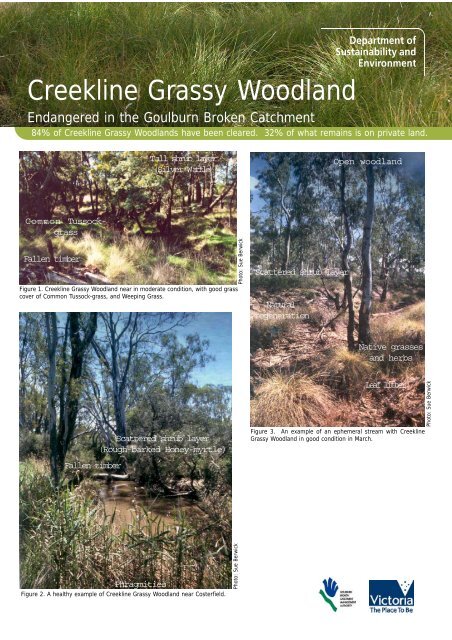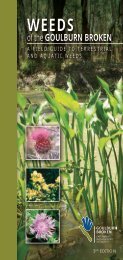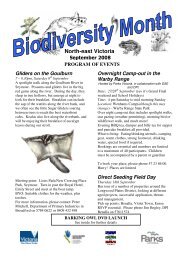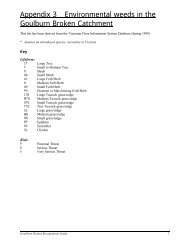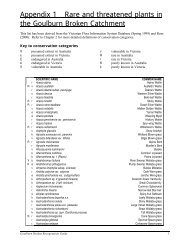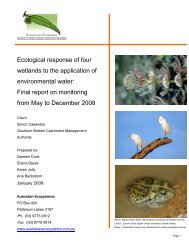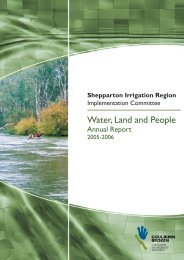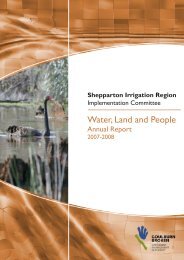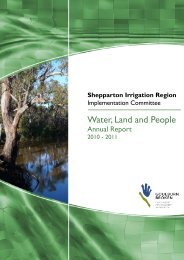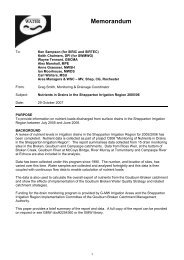Why Creekline Grassy Woodlands are Threatened - Goulburn ...
Why Creekline Grassy Woodlands are Threatened - Goulburn ...
Why Creekline Grassy Woodlands are Threatened - Goulburn ...
Create successful ePaper yourself
Turn your PDF publications into a flip-book with our unique Google optimized e-Paper software.
<strong>Creekline</strong> <strong>Grassy</strong> WoodlandEndangered in the <strong>Goulburn</strong> Broken Catchment84% of <strong>Creekline</strong> <strong>Grassy</strong> <strong>Woodlands</strong> have been cle<strong>are</strong>d. 32% of what remains is on private land.Tall shrub layer(Silver Wattle)Open woodlandCommon TussockgrassFallen timberFigure 1. <strong>Creekline</strong> <strong>Grassy</strong> Woodland near in moderate condition, with good grasscover of Common Tussock-grass, and Weeping Grass.Photo: Sue BerwickScattered shrub layerNaturalregenerationNative grassesand herbsScattered shrub layer(Rough-barked Honey-myrtle)Leaf litterFigure 3. An example of an ephemeral stream with <strong>Creekline</strong><strong>Grassy</strong> Woodland in good condition in March.Photo: Sue BerwickFallen timberPhragmitiesFigure 2. A healthy example of <strong>Creekline</strong> <strong>Grassy</strong> Woodland near Costerfield.Photo: Sue Berwick
<strong>Creekline</strong> <strong>Grassy</strong> WoodlandEndangered in the <strong>Goulburn</strong> Broken CatchmentDescription<strong>Creekline</strong> <strong>Grassy</strong> <strong>Woodlands</strong> occur along the banks of many of the smaller ephemeral(seasonal) streams on the plains and lower slopes of foothills at elevations of 100-200m with an annual rainfall of 400-700mm.These open woodlands have an overstorey usually dominated on the plains by RiverRed Gum. Manna Gum may occasionally be found on the lower slopes of the foothills.There is usually a medium open shrub layer of Silver Wattle, Blackwood, and Wirilda.Rough-barked Honey-myrtle may occur in some <strong>are</strong>as.Seasonal inundation provides good moisture availability to fertile soils supporting agrassy ground layer of Common Tussock-grass, Weeping-grass and Common Wheatgrasswith rushes and sedges. Herbs such as Common Sneezeweed also occur.Species to Look Out ForFlora: Rough-barked Honey-myrtle.Fauna: Carpet Python (e), Barking Owl (e) and Brush-tailed Phascogale (v).Figures 4-7. RiverRed Gum, Blackwood,Silver Wattle,Common TussockgrassPhotos: Mary TitcumbFigure 8. Carpet PythonPhoto: DSE/McCannFigure 9. Barking OwlPhoto: Natasha SchedvinFigure 10. Brush-tailed PhascogalePhoto: Jerry Alexander<strong>Why</strong> <strong>Creekline</strong> <strong>Grassy</strong> <strong>Woodlands</strong> <strong>are</strong> <strong>Threatened</strong>84% of <strong>Creekline</strong> <strong>Grassy</strong> <strong>Woodlands</strong> in the <strong>Goulburn</strong> Broken Catchment have disappe<strong>are</strong>d since Europeansettlement. Many of the remaining examples of this vegetation type <strong>are</strong> degraded. Many of the plants andanimals that rely on this habitat <strong>are</strong> now also threatened, and some <strong>are</strong> extinct. Over 32% of what remainsis on private land. The support of private landholders is essential for the ongoing conservation of <strong>Creekline</strong><strong>Grassy</strong> <strong>Woodlands</strong>.By its nature, riparian land is critical to the lifecycles of many native animals and plants, it provides wildlifecorridors as well as being a refuge for animals in times of drought and fire. It is fragile, and its productivityalso makes it vulnerable to over-use. It performs a vital link between land and water ecosystems.Current threats include, stock grazing (erodes the bank, hinders native plant regeneration, increasesnutrient levels, and causes loss of native species through selective grazing and trampling), lack of nativeunderstorey and ground layer (which attract insect eating birds helping keep the overstorey healthy, andimprove soil health through fixing nitrogen), lack of natural regeneration, weed invasion and loss of treeand ground habitat (through timber harvesting, tidying-up of fallen timber and firewood collection).
<strong>Creekline</strong> <strong>Grassy</strong> WoodlandEndangered in the <strong>Goulburn</strong> Broken CatchmentManagement TipsEncourage natural regeneration by:* controlling rabbits,* reducing competition from exoticgrasses prior to seed fall and* removing stock at least untilseedlings <strong>are</strong> well establishedRevegetate around remnants to bufferfrom introduced pasture and link toother remnantsEstablish off stream wateringInstall nest boxes(particularly forGliders#Weed control - develop plan for action.Spot spray using species specific herbicidesuitable for waterways to preventseed set of target weeds (commonlyPhalaris and Paspailum).Fencing is critical.Retain access, since occasional pulse grazing forweed control or fire fuel reduction may benecessary. Pulse graze for short periods only, withlong intervals between grazing events. Avoid stockaccess when soils <strong>are</strong> wet, to prevent pugging andin spring and early summer to allow flowering andseed-set of native plants.Prevent chemical residue entering anywaterbodies.Leave fallen timber for habitat bothinstream and on banks#Restore native understorey by direct seeding and/ or replanting, especially Silver Wattle, where it isabsentFigure 11. <strong>Creekline</strong> <strong>Grassy</strong> Woodland on private property in degraded condition, with lack of native understorey (including shrubs and native grasses).# May require expert input in decision making and planning. See your local DSE or CMA representative for further advice.Photo: Barry OswaldEstablish riparian buffer strip(well grassed <strong>are</strong>a to filter runofffrom surrounding landuse)where run-off enters streamSome additional tips for erosion control*Stabilise bed with rock or woody debrisand allow beds and bank to be colonisedby grass*Use range of species - grasses, reeds,shrubs and trees*Establish vegetation as far down bankas possible as well as on the bank topFence out stock to help stabilise bankRestoring the native understorey willhelp keep existing trees healthy,improve nutrient cycling and providehabitat for a greater range of speciesFigure 12. <strong>Creekline</strong> <strong>Grassy</strong> Woodland in degraded condition, with tree dieback, and lack ofnative shrub layer and native grasses.Photo: Debbie Colbourne
Conservation Status<strong>Creekline</strong> <strong>Grassy</strong> Woodland is Endangered in the<strong>Goulburn</strong> Broken CatchmentVictorian Riverina bioregion : EndangeredMurray Fans bioregion:EndangeredGoldfields bioregion :EndangeredCentral Victorian Uplands bioregion : EndangeredNorthern Inland Slopes bioregion : EndangeredHighlands Northern Fall:EndangeredFigure 10. A representation of the pre-1750 and present day distribution of <strong>Creekline</strong> <strong>Grassy</strong> Woodland and its mosaics and complexes in the<strong>Goulburn</strong> Broken Catchment. The boundaries of the vegetation have been exaggerated to allow for the small scale of the map. The map wasproduced from Base Data from DSE Corporate Library. The State of Victoria does not warrant the accuracy or completeness of information on this map. Anyperson using or relying upon such information does so on the basis that the State of Victoria shall bear no responsibility or liability whatsoever for any errors, faults,defects or omissions in the information.References:Berwick, S. (unpublished) Pre-1750 EVC mapping, <strong>Goulburn</strong> Broken CMA, Department of Natural Resources and Environment, BenallaDepartment of Natural Resources and Environment (2001) Freshwater Ecosystems 3 Biodiversity Management Issues, Department of NaturalResources and Environment, Melbourne.Department of Sustainability and Environment (2004) EVC Bioregional Conservation Status Table, a support document to: Department of NaturalResources and Environment (2002) Victoria's Native Vegetation Management - A Framework for Action Support Data, NRE.Land & Water Australia (2002) River Landscapes Fact Sheets 1-13, Land & Water Australia, Canberra.Martin, D. and Robinson, J. (2001) Chapter 10 Enhancing streams by revegetating & erosion control from: Earl, G. et al. (2001) Revegetation Guidefor the <strong>Goulburn</strong> Broken Catchment, Department of Natural Resources and Environment, Benalla.Platt, S.J. (2002) How to Plan Wildlife Landscapes: a guide for community organisations, Department of Natural Resources and Environment,Melbourne.Viridans Pty Ltd. (2004) Victorian Fauna Display, Viridans Pty Ltd., Melbourne.Acknowledgments:This project was a partnership between the <strong>Goulburn</strong> Broken Catchment Management Authority and Department of Sustainability andEnvironment, and funded by NAP: Australian Governments and local communities working together to prevent, repair and manage risingsalinity and declining water quality across Australia. Thanks to comments from Alison Oates, Biodiversity & Natural Resource Division,DSE and Glen Johnson, Water and Biodiversity Team, North East DSE; Jenni Nunan, GIS team, DSE, Benalla for producing the maps; forfeedback and comments from the Biodiversity Team in the <strong>Goulburn</strong> Broken and NorthEast, DSE; the DPI LINKS officers and CMOs, theGBCMA waterways and vegetation officers and to all who contributed photographs and support.Compiled by: Mary Titcumb, Department of Sustainability and EnvironmentFor further information about this publication, contact:Department of Sustainability and Environment or <strong>Goulburn</strong> Broken Catchment Management AuthorityBenalla (03) 5761 1611© The State of Victoria, Department of Sustainability and Environment, May 2005.ISBN 1-920742-11-5DisclaimerThis publication may be of assistance to you but the State of Victoria and its employees do not guarantee that the publication is without flaw of anykind or is wholly appropriate for your particular purposes and therefore disclaims all liability for any error, loss or other consequence which may arisefrom you relying on any information in this publication.


